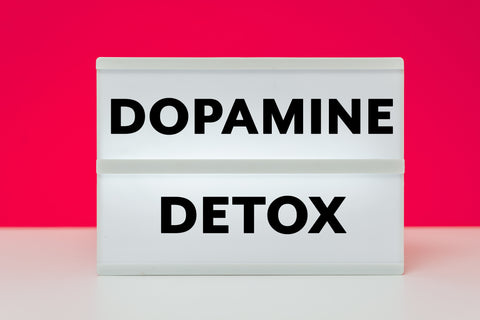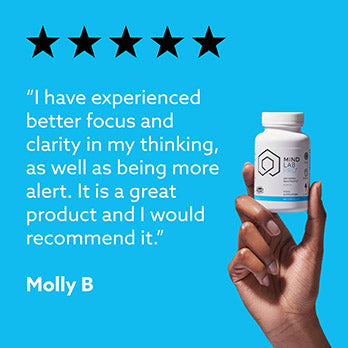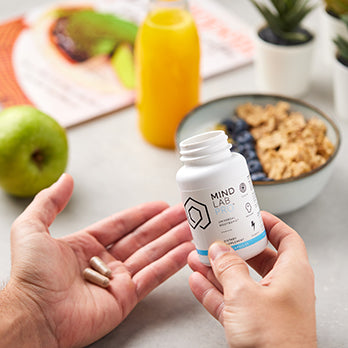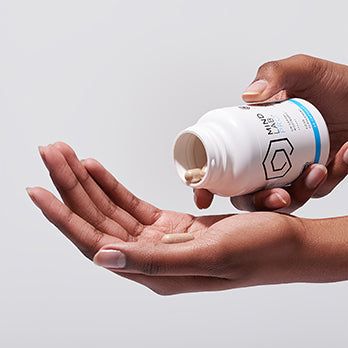It’s not often that neurotransmitters are seen by the mainstream as sexy.
But dopamine has been basking in its own little moment. Its association with feeling good, has allowed it to hang out with the sex, drugs and rock and roll crew.
It’s even made its way into mainstream marketing. Brands are using it as a way to associate a feel-good factor with their product. Follower of fashion? - Come this way for dopamine dressing. Lover of food? - Check out the dopamine diet. Interior enthusiast? Get yourself some dopamine decor. You get the picture, it’s everywhere - the message is:
“Our stuff makes you feel good.”
And while our inboxes and feeds are full of dopamine content, there’s more to it than that...There’s a rumor that dopamine may not be the fun loving guy we all think they are.
Poor dopamine may be moving from media darling to tabloid scandal material - with accusations of being the neurotransmitter to blame for addiction, shortened attention span, obesity and maybe even online trolling.
When things start to turn sour, can we just shout:
“The dopamine made me do it!”
In this article we’re going to look at
- What is dopamine
- The effects of high levels
- How pleasure and pain are linked
- What is a dopamine detox
- Benefits of a dopamine detox
- Balancing your brain without a dopamine detox
- Natural supplements to help
What is dopamine?
Dopamine is a chemical made in our brain that’s involved with motivation and movement. It’s released when we do something pleasurable.
Dopamine can be seen as a by-product of reward. It’s crucial in helping us to pay attention and learn about the signals in our environment that are motivationally relevant to us.
Dopamine encourages us to make moves in the pleasure direction in order to repeat and relive that feeling again.
If dopamine was a person, they’d always be reminiscing about the good times. They’d be lingering around in the background, minding their own business. But then suddenly leaning in and whispering, “Oh hey - I was just thinking……remember that time we found that little bakery and we ate those INCREDIBLE salted caramel donuts? - I think we should do that again. Yeah we should do that now.”
Dopamine is your partner in crime. It’s fun right? And if dopamine nudges us into action towards all of this good stuff, how is that bad for us?
Too much of a good thing. When dopamine goes bad.
Our brains are hardwired to pursue reward. And this is where we can sometimes come unstuck. It’s this inherent pursuit of pleasure that links dopamine to addiction.
Let’s keep this light - it’s not all about out-of-control cocaine habits and rinsing the inheritance in one night at the casino. The drug of choice might be playing video games, or shopping or scrolling for ridiculously cute animal videos on instagram.
If you’ve ever held-off watching your favorite tv programme, only to switch it on and within 10 minutes, find yourself absentmindedly scrolling through your phone - there’s a reason for that.
Everything is so accessible, so quick, so easy, so intuitive, so reinforcing. In a dopamine rich world, we’re all turning into addicts.
And it’s not even about the jackpot anymore. Obtaining the reward is old news, it’s now about the pursuit of it. The relentless pursuit of it. And our primitive hardwiring doesn’t know what to do with all these stimuli.
Your primitive self is tutting at you right now, arms folded, shaking it’s head and uttering the words,
“It wasn’t like this in my day.”
And they’re right. In their day our ancestors were motivated to engage in behaviors necessary for survival. Food, shelter, not getting savaged by a saber-toothed tiger. It was life and death stuff. Imagine how disappointed they’d be if they knew we were sitting here doom-scrolling for another “Matted Cat Who Looks Like a Piece of Wood Gets a Glow-Up” video.
It turns out that today, more is more. Our focus has shifted. And so has our pleasure/pain balance.
Pleasure and pain. It’s like riding a bike.
In the same parts of the brain that process pleasure, we also process pain. And these need to be balanced. If you imagine it’s like riding a bike, and when we experience pleasure, the bike tips one way and when we experience pain it tips the opposite way.
Leaning too long or too far on either side could cause us to tip over. So we keep pedaling in order to keep balanced.
Our brains also work very hard to restore a level of balance - homeostasis.
Every time we do something pleasurable, we get a little release of dopamine in a part of our brain called the reward pathway and the balance tips to the side of pleasure.
But now the bike is tipping, and balance needs to be restored. To do that, the brain starts regulating dopamine production and transmission.
But it doesn’t just bring it back down to an equal level. The brain is over cautious, and the amount that it brings the bike over to the pain side is disproportionate to the amount of pleasure experienced. It dips even further. It’s pain and then a little bit more pain. The bike is now weighted on the pain side. You’re literally coming down.
Swipe right for dopamine
It’s normal to want more. Our environment has been optimized for convenience and reward. Algorithms, social media posts, video games, ranking systems, visual reward, aural reward, swipe left, swipe right - it’s a 360 assault on our dopamine levels.
We want to recreate that feeling, and the obvious way to do it is through repetition. The pathway to addiction. Keep eating, keep playing, keep swiping. But there’s a problem with that. The initial feeling of pleasure gets weaker and shorter the more you repeat it, and the tip towards the pain side gets stronger and longer. Addiction leads to Neuroadaptation. We need more to get the same effect.
Needing more of something to feel pleasure, and feeling less pleasure than you used to with the same dose, is called tolerance.
And that’s how addiction can start. We’re wired to seek it, our environment is optimized to exploit it, so it’s easy to see how it can start to control us.
How do we regain control?
We can’t rewire our brains - but we can look at our daily habits and our environment to make changes within it. A trend that’s emerged over recent years is the concept of a dopamine detox.
What is a Dopamine Detox?
A dopamine detox is a practice aimed at reducing or eliminating the excessive stimulation of the brain's reward system by temporarily abstaining from activities that release large amounts of dopamine.
The goal is to reset and recalibrate the brain's reward system, allowing it to become less dependent on constant stimulation and fostering a greater appreciation for simple pleasures. The idea is that by taking a break from dopamine-inducing activities, individuals feel more in control of their habits, improve focus and productivity, and cultivate a healthier relationship with technology and other potentially addictive behaviors.
Dopamine Inducing Activities
We pick our poison and these activities will vary from person to person. But the main offenders are:
- Social media
- Video gaming
- Streaming services
- Junk food
How Do I Detox From Dopamine?
The dopamine detox, also known as dopamine fasting, is a form of cognitive behavioral therapy (cbt) developed by Dr. Cameron Sepah. It refers to the practice of temporarily abstaining from activities that trigger excessive dopamine release in the brain.
This can include avoiding social media, video games, listening to music, binge-watching TV shows, consuming sugary foods or drinks and even engaging in intense exercise routines.
The world's smartest
newsletter
Get limitless brainpower insights. Direct to your inbox.
Plus offers, discounts & early
access to sales.
How does a dopamine detox work?
It’s worth mentioning here, you’re not actually detoxing from dopamine, you’re detoxing from the substances and stimuli that cause a release of dopamine. Sepah himself told the New York Times “Dopamine is just a mechanism that explains how addictions can become reinforced, and makes for a catchy title. The title’s not to be taken literally.”
To get the most out of the experiment, you need to know what it is that’s not working for you. How is it making you feel? Identify the cause, what has become problematic and abstain from that.
By removing the stimulus, you are compelled to find other activities to keep yourself busy.
It’s an exercise in mindfulness. Going for a walk, enjoying activities in nature, catching up with friends. Allowing our brains to find pleasure in simpler things.
Basically, do we all just need to be a bit more bored?
Sort of.
You might read about journaling, breathing exercises, going for a walk and think, “That sounds inspiring.” You may also think, “That sounds dull. Where’s my Call Of Duty, where’s my Netflix, where’s my dog-adopts-a-baby-otter video?”
When we're hooked on immediately accessible substances and behaviors, those other activities can’t compete. In order to make the more modest rewards rewarding again, we need to abstain from the highly dopaminergic substances and behaviors that have previously hijacked our reward pathway.
If you want to break the cycle - you have to trust the process
Benefits of a Dopamine Detox
Real talk: There are no official clinical trials supporting a dopamine detox specifically. But advice such as get outside, put the phone down, connect with the people around you - is perhaps not groundbreaking - but it does all sound very sensible.
Any activity that allows time for reflection and connection is a step in the right direction and has to be a good thing. Those that have have tried the detox themselves report:
- Improved focus
- Increased motivation
- Improved mood and mental health
- Improved relationships
- Enhanced creativity
- Lowered compulsive behaviors
It makes sense, removing the distraction, the dependency and the time physically taken up with our drug of choice, offers a whole new opportunity to find new activities and alternative behaviors.
Dopamine detoxing, while primarily associated with personal well-being can also be viewed through the lens of social responsibility. By consciously limiting our exposure to excessive dopamine-inducing activities such as social media and video games, we promote a healthier balance in our lives.
The phone no longer rules, the tv has to back off and our distractions and recreational deadlines have disappeared. This, in turn, allows us to engage more meaningfully with our friends, families and communities, fostering stronger connections and fulfilling our social responsibility to contribute positively to society. Embracing dopamine detoxing not only benefits our own well-being but also enables us to be more present.
For young adults a detox may be even more beneficial. A 2016 study showed that media multitaskers searching for that instant dopamine hit from social media, may struggle maintaining focus long term.
The dopamine detox may even be a good starting point for any individuals with health conditions seeking a holistic approach to their well being. New research from Swansea University shows that reducing social media use by 15 minutes a day can improve general health and immune function along with reducing levels of loneliness and depression.
Ways to balance your brain without a dopamine detox
If the idea of a fully fledged dopamine detox is already bringing you out in a cold sweat, the good news is there are alternative ways to balance your brain's dopamine levels. Consider incorporating these activities and practices into your daily routine:
-
Mindful meditation: Practicing mindfulness meditation has been shown to improve focus, reduce stress and anxiety, which can contribute towards balancing dopamine levels in the brain.
-
Nutrition: Consuming foods rich in tyrosine (an amino acid that helps produce dopamine) can support healthy neurotransmitter production. Additionally, avoid excessive sugar intake as it disrupts dopamine levels.
-
Sleep hygiene: Ensuring adequate sleep is essential for maintaining balanced brain chemistry, aim for 7-9 hours of quality rest each night by following good sleep hygiene practices.
-
Moderation with technology use: Instead of completely avoiding screens during your waking hours, try setting boundaries on how much time you spend using devices like smartphones or computers each day. Avoid screen time for at least 2 hours before going to bed.
Since dopamine levels influence mood, finding the right balance between pleasure-seeking activities and maintaining optimal cognitive function are crucial for overall well-being, as well as looking after your mental health.
Keeping up a healthy daily routine is key to maintaining good brain health and staying productive. Another way to maintain your brain health is by adding a natural supplement to your diet.
In the next section we’ll look at what supplements work best to balance dopamine levels and how you can tell whether you’ve found a good one.
Natural supplements
We’ve established that maintaining a harmonious dopamine balance in the brain is essential to cope with our hectic lifestyles.
Another way to help achieve this is through health products such as natural supplements. The benefit of these are they help to optimize cognitive functioning as well as improving overall wellbeing.
In this section, we’ll explore various types of natural supplements that can aid in balancing your brain's dopamine levels without any unwanted or harmful side effects.
Types of Natural Supplements That Can Help Balance Your Brain's Dopamine Levels
-
L-Tyrosine: L-Tyrosine is an amino acid compound used to synthesize catecholamine neurotransmitters involved in memory, mood and mental processing – including dopamine, epinephrine, and norepinephrine.
-
Rhodiola Rosea: Rhodiola rosea is believed to stimulate and sustain cognition-critical neurotransmitters — including norepinephrine, dopamine, and serotonin. It may further optimize these neurotransmitters by helping their transport across the blood-brain barrier.
-
L-Theanine: L-Theanine is an amino acid found in green tea and some mushrooms. It can cross the blood-brain barrier to boost dopamine levels and other brain chemicals that promote feelings of calm.
-
Citicoline: CDP Choline, one of the major components in Citicoline, encourages dopamine release and improves overall dopamine levels by acting as a dopamine agonist and inhibiting dopamine reuptake.
Looking out for these natural cognitive enhancers will help you find a supplement that not only balances your dopamine levels, but also has associated benefits linked to improved mood, memory and focus.
These cognitive enhancers are also known as nootropics. If unfamiliar with the term, you can learn more about nootropics here. In short - nootropics are defined as compounds, supplements, or drugs that are designed to improve cognitive function.
Not all nootropics were created equal
When you're looking for a supplement to optimize your brain health, there’s a few things to look out for. It should be natural, stimulant free, with no side effects, the right dosage and it should be tested for purity and potency. And perhaps most importantly, it should have independent scientific research to back up its brain boosting claims.
Mind Lab Pro® is the world's first Universal Nootropic™ formula. A ground-breaking stack of 11 evidence-backed nootropic ingredients - in advanced forms. Intelligently blended to complement each other and work better together. Making Mind Lab Pro® more than the sum of its parts. It supports multiple brain pathways to enhance all types of cognitive performance in all types of people.
If you’re looking to optimize your healthy routine, consider introducing a supplement such as Mind Lab Pro® to your daily routine.
When life has been optimized to trigger our dopamine response, and our brains are wired to keep it balanced, you can see the struggle to maintain equilibrium.
The jury is still out on whether a dopamine detox can reset the reward pathways in your brain. But with the mainstream narrative coming round to the importance of mindfulness, and a shift in focus to nutrition, brain health and wellness - it feels like maintaining a balance is becoming more achievable.




































